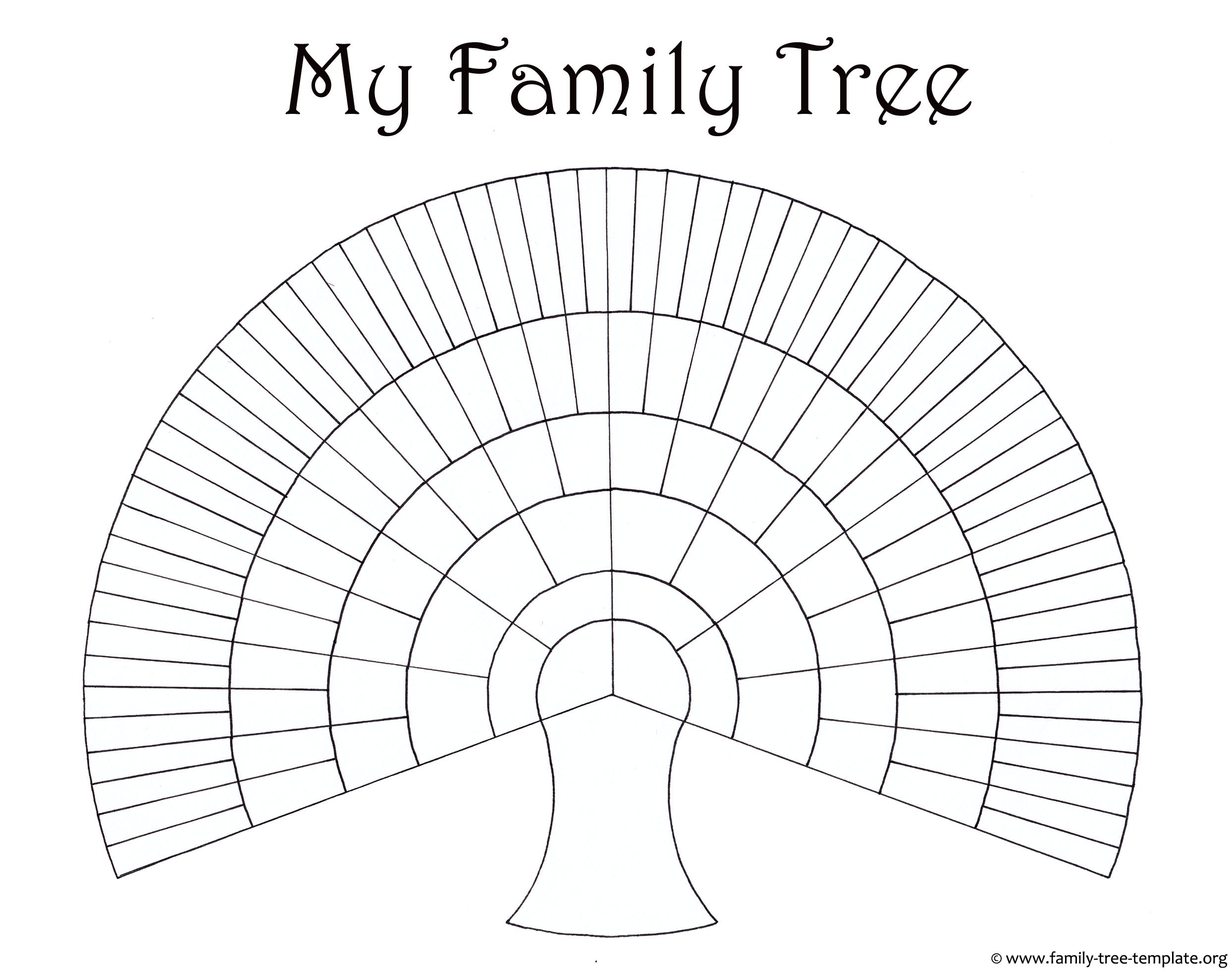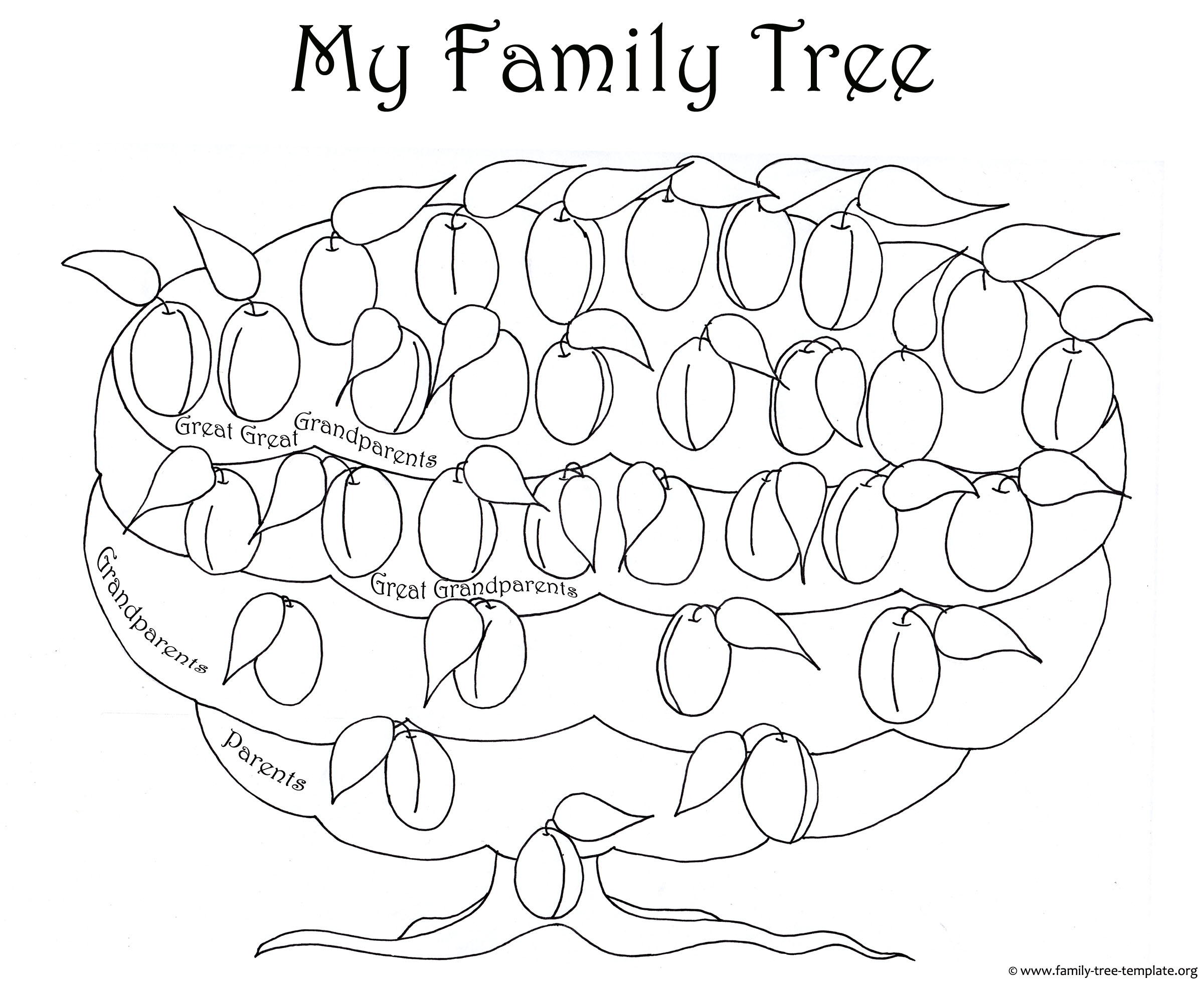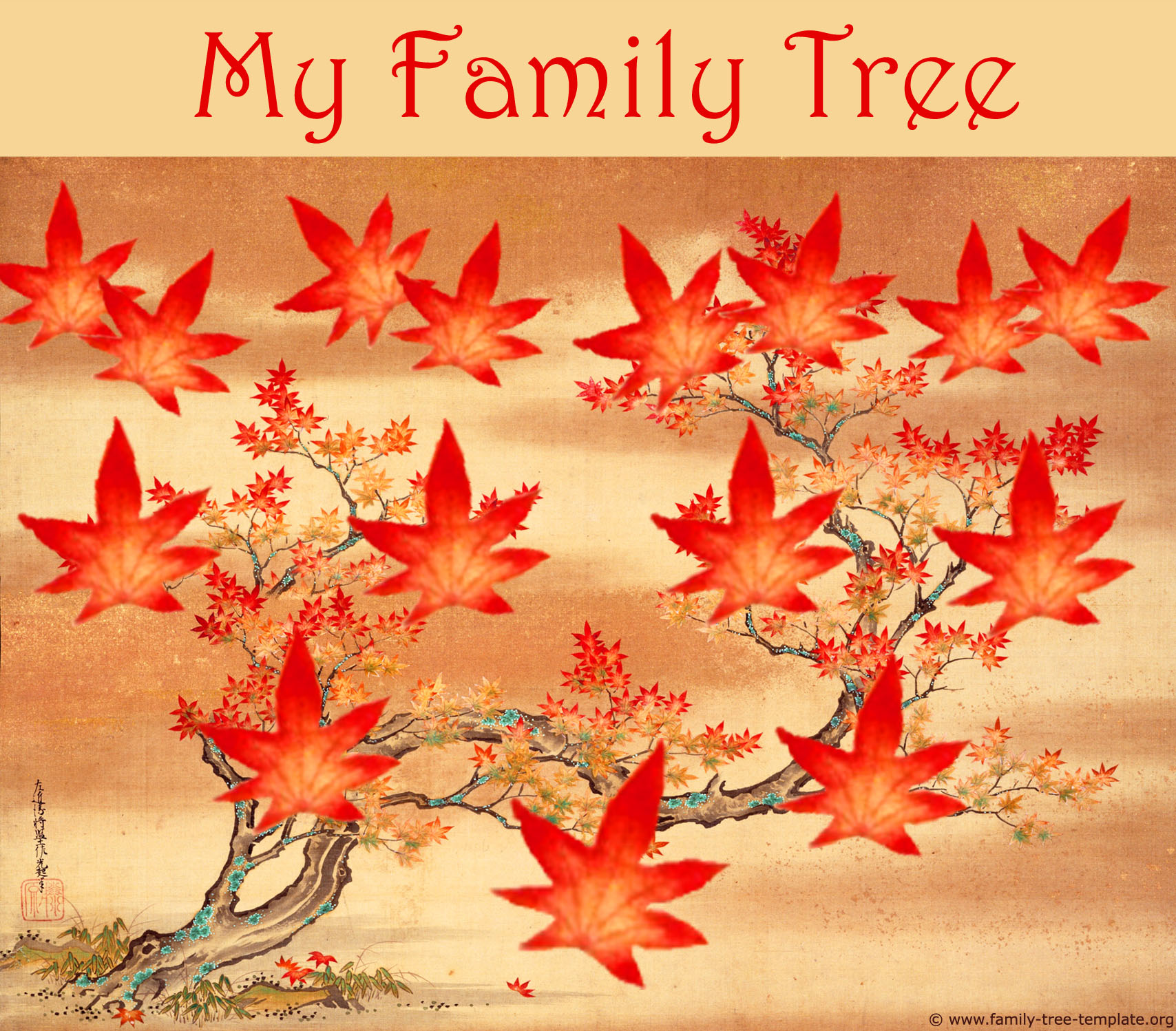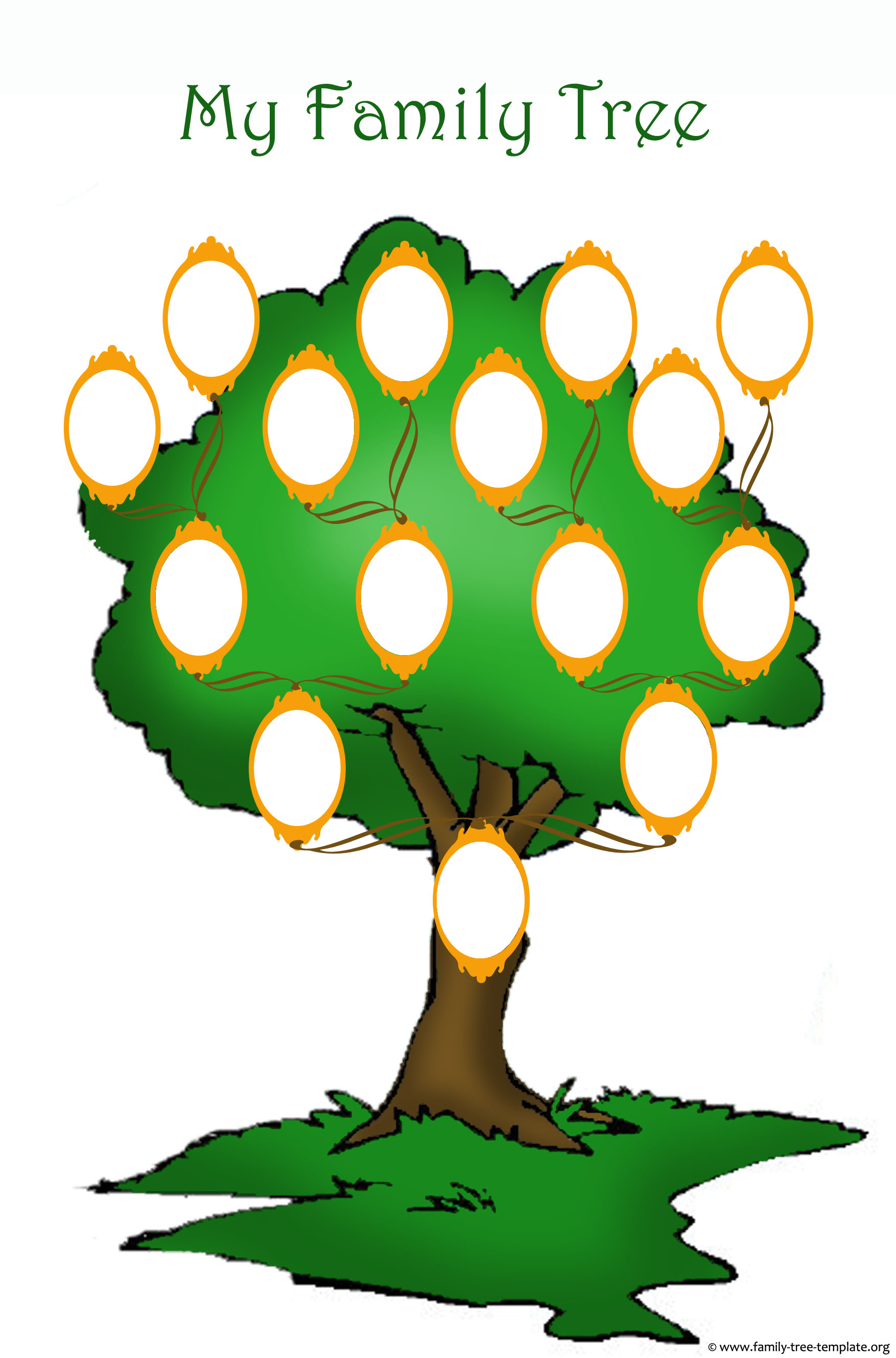Blank Family Trees Templates – Using Genealogy Graphics to Make Great Ancestry Charts
Blank family trees will get you started on the task of doing the research into your family history, and you can decorate using this tree with all of the fun genealogy graphics and family tree clipart that you want.
In reality, making a family tree with your kids can be a lot of fun, and you may find that making ancestry charts and free genealogy charts with them can help you to learn a lot more about where you come from.
If you’re going to make family trees, it’s important that you do it right!
Big Family Tree Template Tracing Your Ancestors all the Way Back to Your Great-Great-Great-Great-Grandparents
This blank family tree chart is ideal for printing with its size: 25,27 x 20,01 cm in 250 dpi. When printed, just start with writing your name in the tree trunk, then insert your parents names in the two darkest areas of the tree and then take it from there. 🙂
Big Family Tree Chart for Kids to Print and Color
This tree is the exact same as the one above and can become an amazing piece of artwork if you let your kids color the squares in different colors. 🙂
Blank Family Plum Tree for Printing and Filling out
This is one of my more arty tree charts that I hope you will like. The dimensions (24,39 x 20,01 cm in 250 dpi) are ideal for printing out on an A4 paper.
The Plum Tree Chart as a Coloring Page for Kids
With the many different areas to color this coloring page can be a really fun adventure for kids. Also who says that the plums have to be the same color. 😉
Printable Family Tree Template Old Japanese Style
I find old Japanese painting fascinating, beautiful and very elegant, so here is an old Japanese painting I transformed into a family tree chart. The big leaves represent family members. The image size is 22,83 cm x 20,03 in 190 dpi.
Spring Pine Tree to Print
Here a lovely photo from one of a spring walk late in the afternoon. The image size of this family tree is 24 cm x 18,42 in 200 dpi.
Fun Printable Family Tree Template for Kids
This cute and simple family tree gives your kids the opportunity to either draw the faces of family members, glue in photos or simply just write their names. The image size is 27 cm x 19,82 in 250 dpi.
Another Genealogy Family Tree for Kids
How about the ‘taste’ of early summer in this family tree. The image quality is high and the size is perfect for an A4 piece of paper. The image size of this chart is 25 cm x 19,87 in 200 dpi.
High Resolution and Printable Blank Family Tree Diagram
Here is a pretty one, I’m quite happy with myself. Perhaps this is for the older child as there are 5 generations to fill out. The image size of this chart is 26 cm x 19,4 in 250 dpi.
5 Generations Family Tree
This photo was taken on a trip to the zoo in Berlin, Germany, this spring. You will notice the the ‘dpi’ is not as high as many of the other pictures on this page. The reason for that is that there are so many details in the picture that I had to lower the resolution quite a bit. Otherwise this page would take forever to load. The image size of this chart is 22,99 cm x 18,34 in 190 dpi.
Tracing Your Family Tree
If you’re going to make your own family tree, it’s important that you have everything ready when it comes time to fill out the blank family trees.
You will have to gather all of the information first, and you will need to do the work in order to get everything ready to make your family tree. If you’re going to do the work, it’s best that you do it right!
Here are some tips to help you as you go about planning your family tree and gathering everything that you will need:
- To begin, it’s important that you get as much information as you can from immediate family, such as grandparents, aunts, uncles, etc. They will usually have documents, pictures, and old information that you can use, and you would do well to collect this information in one place. If you can’t have the original documents, at least scan or take a picture of them so that you can have them as part of your research.
- Do interviews with your family, as that will help you to find out about your relatives and ancestors first hand. You may be able to find out a lot from your grandparents about their ancestors, or your other immediate relatives can be a great source of information. Make sure that you write down everything that they tell you about during the interviews, and store the information for use at a later date.
- Choose a single surname that you want to research, the surname of your family. If you work with too many names at a time, it can lead to confusion and mixed research. Keep it simple and stick with one of the family names as you get into ancestry websites, family record searching services, and so on.
- Find out if you have a Family History Center in your area, and take the time to visit it in order to find out more about your family. The Mormons keep these centers in their churches, and they are open to the public as a means of finding out more about your family. You will find that these places will be an excellent source of information, and you can get a whole lot on your family by checking them out.
- Be certain that you take pictures of all of the documents that you find, as that way you will be able to print out the documents and have them as part of your research. Take notes on all of the research that you do, organizing your research on index cards for each of the members of your family that you’re researching. It may be fairly time consuming now, but it will save you a whole lot of time later when you have to scramble to remember some fact or name that you found in an obscure document. You can take the index cards with you wherever you go, and they will be a huge help in solving the puzzle of your family’s ancestry.
- Find out where your family lived before moving to the city where you are now, and take the time to visit that town or city in order to find out more. Obviously, you’re not going to have a lot of time to take off work just to do your research into your family history, but you may want to take a vacation to visit some of the places where your family members lived in the past. If your family comes from overseas, it can be a good idea to find out more about your heritage by visiting the country – and it will be an excellent time to do some research.
- Remember that surnames will change over time, and there are many people that will have a similar surname. If you don’t find the person that you’re looking for with the last name Johnson, try looking for Jonsson or Jonson, as they will be alternative spellings that are used by different ethnic groups. You may just find what you’re looking for if you try these alternative spellings, and they can give you a better insight into your family and its heritage.
These are a few tips that will help you to trace your ancestors back as far as you can, and they can actually help you to get quite far. It’s going to take a lot of time and work to do the digging into your family history, but it will be worth it in order to find out as much as possible about where you come from, who your ancestors were, and what rich anecdotes your family history contains.
You may just learn a bit more about yourself, your parents, and the reason that you are who you are!
Using the Internet for Research
The internet is probably one of the best sources for research, as there will be hundreds of archives and record storage databases that you can access with the press of a few keys.
The truth is that the average genealogist doesn’t even need to get up from his chair to do the research, as they will be able to find out everything you need to know about your family history just by getting online.
If you want to use the internet for your research, here are some tips to help you get as much information as you can without having to leave your house:
- Start with the obits – Obituaries are some of the best places to start looking for information on your family, and many sites will provide you with death notices and obituaries that have been taken from newspapers from around the country. These notices and obits can go back for generations, or at least for as long as newspapers have been in circulation in the country. It’s always a good place to start, as you can find out the date that your ancestors died and take your research from there.
- Online cemetery transcription sites – If you can’t find the information that you’re looking for in the obits, you may want to check the cemetery transcription websites. These sites will usually provide information that has been gathered by people going through the cemeteries around the world, information that can include names, dates, and so on. You may be able to find a lot of information thanks to the volunteers that went and did all the gathering of the information, so it’s an excellent place to look.
- Death index search – The last document created for most people will be their death record, and this will often be a good place to start doing research on your family and ancestors. You can do a search through the death indexes, and you will usually be able to come up with many names to start looking into. It will be easier if you know where your ancestors died, as that way you will be able to narrow down the list and only look through the correct names from the correct places.
- Check census records – The U.S. Government has run a census pretty much every ten years for the last century or two, and these census records will be a great place to check for your ancestors. If you know where your ancestors lived, you will be able to find out more or less what decade they died in by checking the census records. If they were part of the census in 1910 but weren’t there in 1920, you have a pretty good idea of when to start looking for their death records.
- Pedigree database search – There are many sites that are dedicated to providing information to genealogists, amateurs and professionals alike. These pedigree databases will be an excellent place to continue your search, though you may need to pay for a membership in order to access the sites. The databases contain all kinds of records and information that will be very helpful in your search for your family, and gaining access to them will be an excellent way to go.
- Check out library websites – Most of the local libraries will have a lot of information stored, specifically on people that lived in the city or town. If you know which city your ancestors lived in, you should take the time to get on the website belonging to the local city library in that town. It may just be that they have information that can help you, and you will be able to get that information free of charge.
These tips can help you to use the internet as a powerful tool for your research, and the truth is that you may be able to find most of what you need without having to leave your home.
You probably will have to go do some legwork at the local city hall or public archives, but most of the information that you need will be easily accessible if you just know how to use the internet to do the research for you!
A Few Mistakes to Avoid
Being a genealogist doesn’t mean that you’re perfect, and there are many times when you will be likely to make a mistake in the research into your family history. Here are a few mistakes that you would do well to avoid:
Forgetting Living Family
Just because your family is alive, that doesn’t mean that you should forget to include them on your family tree. The dead ones are the ones that will require all the work, so many people end up forgetting to do research on their living family.
The truth is that tracing your living family back to their birth can often lead you to find information on their parents, which can help you to start your search off on the right foot.
Accepting Records too Easily
Many people do research into their family, and when they find one record or paper that provides them with information, they accept it as fact.
You can’t accept everything too easily, and you would do well to double check all of your records in order to be certain that the information you have is correct. You should try and corroborate it with at least two sources in order to ensure that it really is correct.
Sticking with One Surname Spelling
When you are doing research into your family history, chances are that your surname has changed over time. In fact, it’s guaranteed that your surname has changed in the generations that you are researching into, so don’t stick with just the current spelling of your last name.
Try all of the variations of your name, and try to find out if and when your family may have changed its name.
Skipping Steps
Some people like to skip straight to the famous ancestor that they “know” they’re related to. However, in order to prove this connection to the ancestor, you’re going to have to document your entire family history tracing all the way back to that ancestor. It’s going to take a lot of work, so don’t skip steps. Find out who each of your family members are one generation at a time, and only once you have sorted one generation should you move on to the next one.
These mistakes will cost you time, and they may cause you to make mistakes in your family history research.
Avoid them and get your family tree right!
Pages on This Site You Might also Like
Don’t know what type of family tree you want to use? Take a look at the types on the A Printable Blank Family Tree page!
Not sure of where to start looking for your family history? Check out the Family Tree Chart page for some good starting place!
The Family Tree Forms page can give you some great ideas of how you can make your family tree easily and quickly!
If you don’t know how to use templates to make your family tree, check out the Family Tree Templates page for some simple pointers!
There are many tools that you can use for your family tree research, and the Free Family Tree Template page will help you learn about a few of them!
Want to know how to fill in the information in your family tree? The Free Family Tree Templates page will give you all the tips you need to make filling out you chart easy and quick!
You can learn how to make your family tree chart just the way you like it on the Make A Family Tree page!
Do a fun family history project with your children by making a family tree template for kids!
Go to the top of this article
Go to the homepage of Family Tree Template










